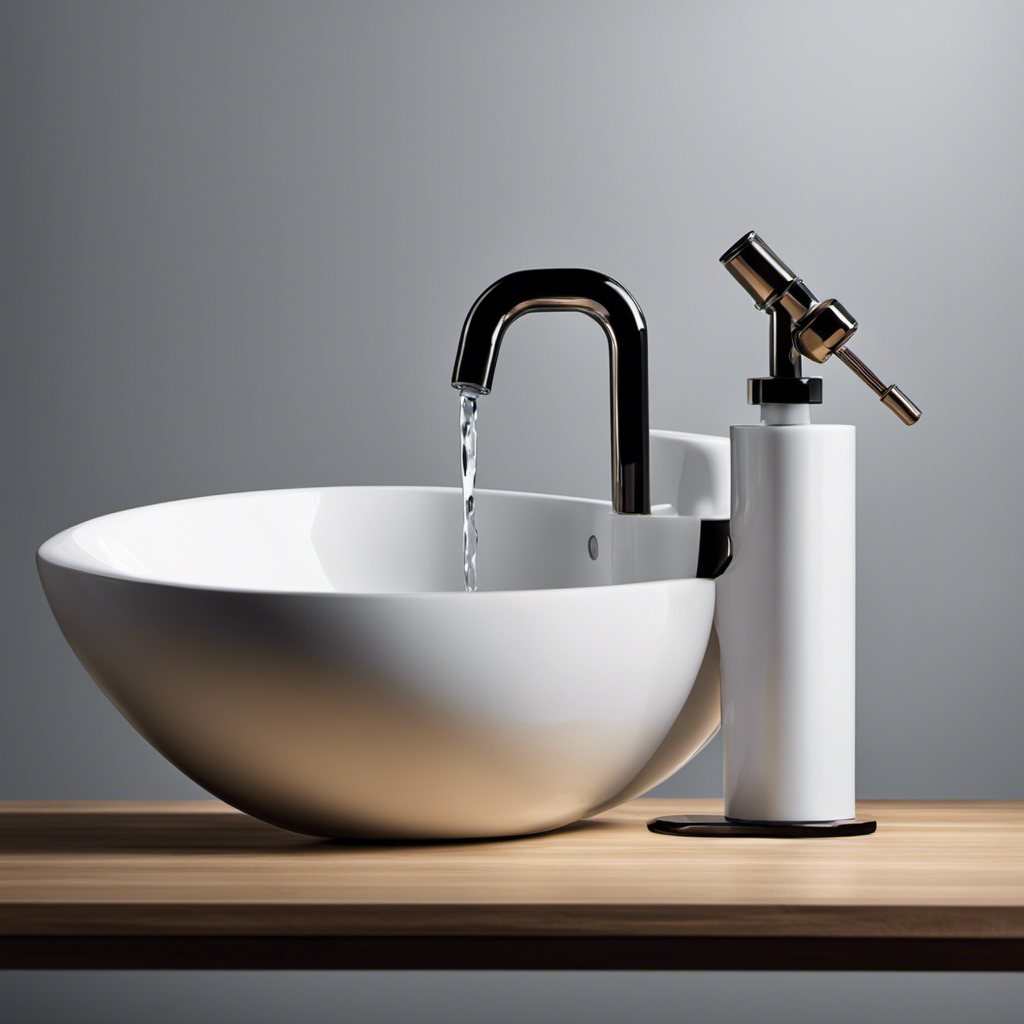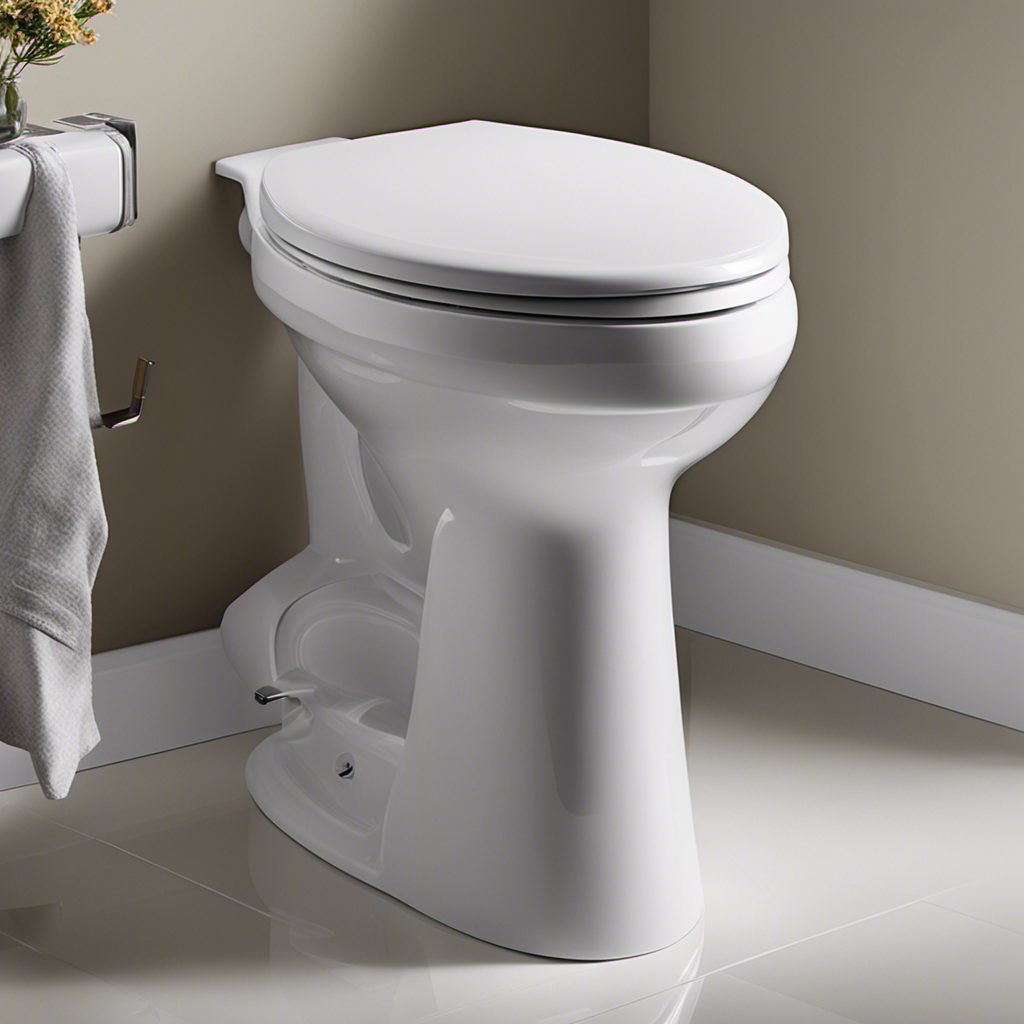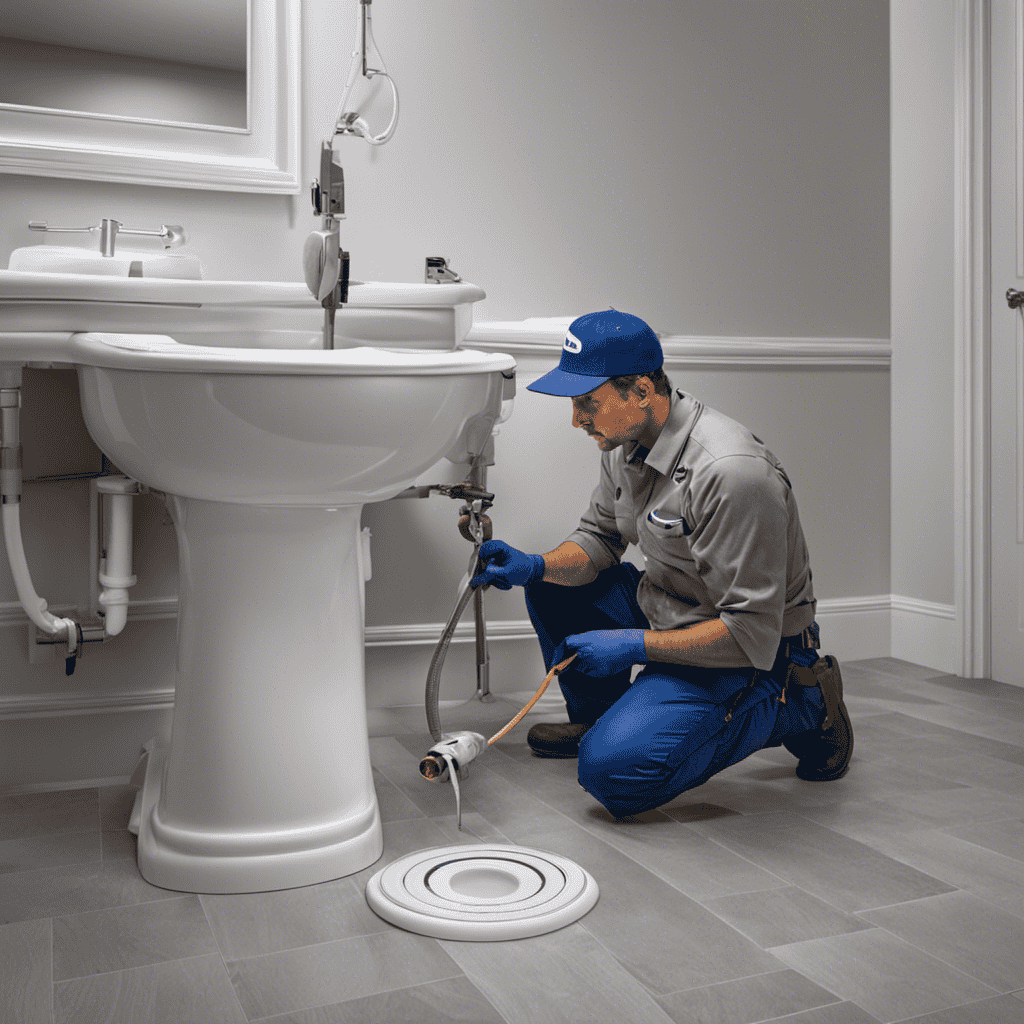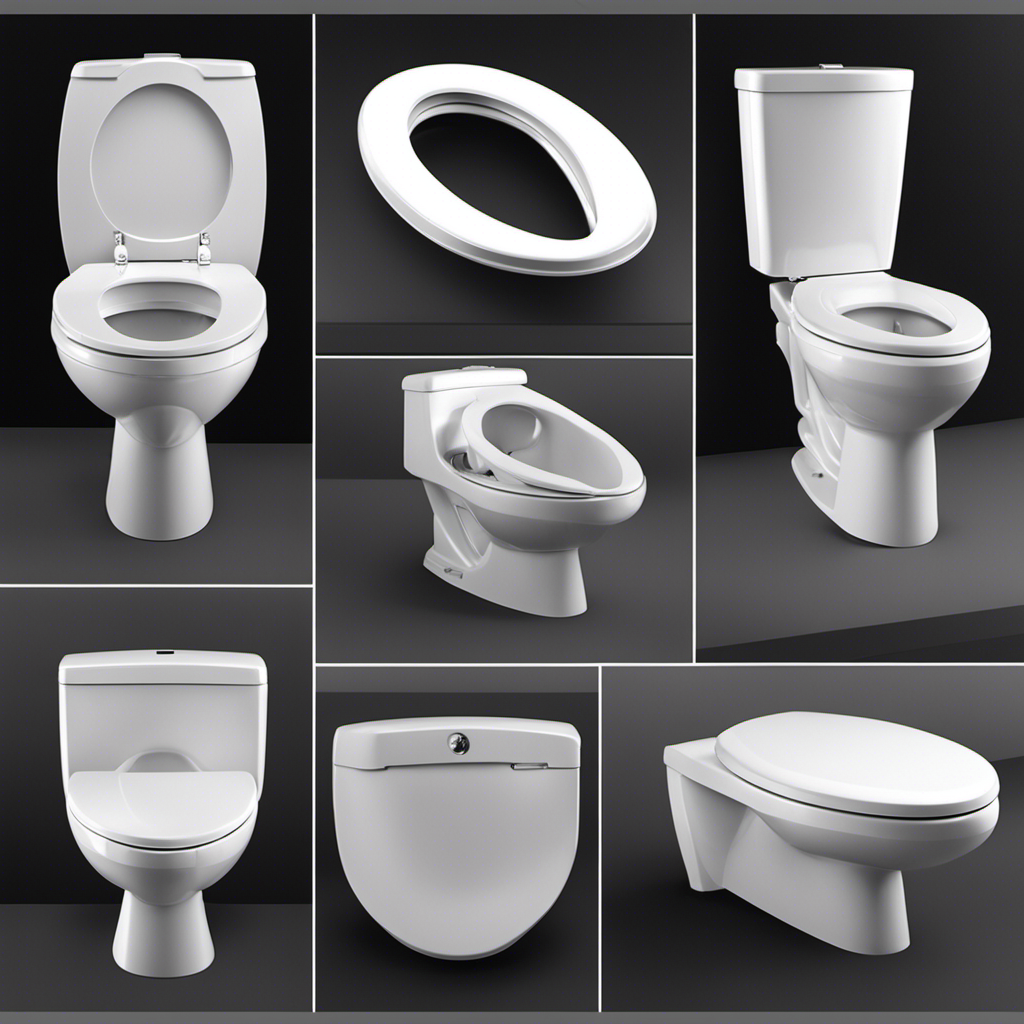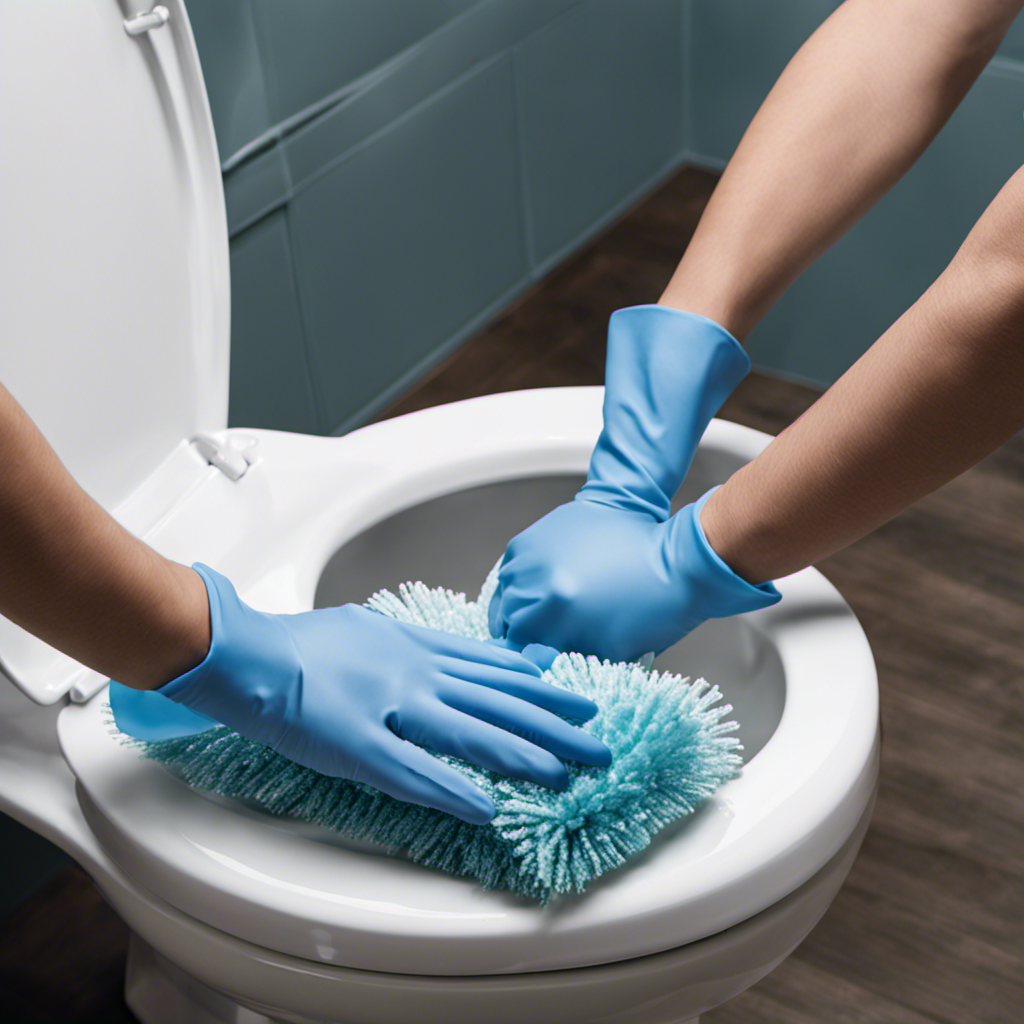Have you ever wondered how to increase the water level in your toilet? Well, look no further! In this article, I will guide you through the step-by-step process of checking the water level, understanding the components of a toilet tank, and adjusting the float ball or cup.
Additionally, I’ll provide insights on cleaning the toilet fill valve, clearing blockages in the toilet bowl, and even replacing the toilet flapper.
So, let’s dive in and learn how to ensure a properly functioning toilet!
Key Takeaways
- Lift the lid of the toilet tank and inspect the water level.
- Adjust the float arm or the water level adjustment screw to increase the water level if it’s too low.
- Adjust the float arm or the fill valve height to lower the water level if it’s too high.
- Regularly clean the fill valve to improve water level without adjustments or replacements.
Checking the Water Level in Your Toilet
To check the water level in your toilet, start by lifting the lid of the tank. This is an essential step in toilet water level maintenance. By inspecting the tank, you can troubleshoot common toilet water level issues.
Once the tank lid is off, look for the fill valve, which is usually located on the left side. The water level should be about an inch below the overflow tube. If it’s too low, adjust the float arm or the water level adjustment screw to increase the water level. If the water level is too high, adjust the float arm or the fill valve height to lower it.
Properly maintaining the water level in your toilet ensures optimal flushing performance and prevents potential problems.
Understanding the Components of a Toilet Tank
Take a moment to familiarize yourself with the various parts inside your toilet tank. Understanding these components is essential for proper toilet tank maintenance and troubleshooting toilet issues.
Below is a table detailing the main parts found in a typical toilet tank:
| Component | Function |
|---|---|
| Fill Valve | Regulates water flow into the tank |
| Flush Valve | Controls water release during flushing |
| Flapper | Seals the flush valve opening |
| Float Ball/Cup | Determines water level |
| Overflow Tube | Prevents tank from overflowing |
| Trip Lever | Initiates flushing mechanism |
Toilet tank maintenance involves inspecting these parts regularly for any signs of wear or damage. Troubleshooting toilet issues often requires adjusting or replacing faulty components.
Now that you have familiarized yourself with the various parts inside your toilet tank, let’s move on to adjusting the float ball or cup, which directly affects the water level in your toilet tank.
Adjusting the Float Ball or Cup
When it comes to adjusting the water level in a toilet tank, there are a few key points to consider.
First, the float ball adjustment involves setting the height of the float ball to control the water level inside the tank.
Second, the cup level adjustment involves adjusting the position of the cup or fill valve to regulate the water level.
Lastly, increasing the water level can be done by adjusting the float ball or cup to allow more water to enter the tank.
Float Ball Adjustment
Adjust the float ball to increase the water level in your toilet. The float ball is a crucial component that helps regulate the water level in the tank. If you’re experiencing low water levels or any other common toilet issues, it may be necessary to troubleshoot and adjust the float ball.
First, turn off the water supply to the toilet by shutting off the valve located near the floor.
Next, remove the tank lid and locate the float ball. If the float ball is damaged or not functioning properly, it may need to be replaced.
To adjust the float ball, simply bend the metal rod attached to it. Bending it upward will increase the water level, while bending it downward will lower it. Make small adjustments until the desired water level is achieved.
Cup Level Adjustment
To adjust the cup level, simply grasp the cup and bend it slightly to achieve the desired amount of water in the tank. This cup height adjustment is crucial for maintaining the water level in your toilet tank.
Here are some key points to consider when adjusting the cup level:
-
Proper water level: Adjusting the cup height ensures that the water level in the tank is neither too high nor too low, which can affect the flushing efficiency.
-
Water conservation: By adjusting the cup level, you can optimize the water usage and prevent excessive water wastage.
-
Flushing power: The cup height adjustment directly impacts the flushing power of your toilet. Finding the right balance is essential for a powerful flush.
-
Troubleshooting: If you notice any issues with the water level or flushing performance, adjusting the cup level can be a simple solution before calling a plumber.
Increasing Water Level
After adjusting the cup level and still finding the toilet water level inadequate, the next step is to consider increasing the water pressure. This can help ensure a sufficient amount of water is delivered to the toilet bowl during each flush. Troubleshooting leaks is also crucial in maintaining the desired water level. Leaks can result in a decrease in water pressure, leading to a lower water level in the toilet. To assist you further, I have provided a table below that outlines some common causes and solutions for troubleshooting leaks.
| Problem | Solution |
|---|---|
| Flapper valve not sealing | Replace the flapper valve or ensure proper alignment |
| Fill valve leaking | Replace the fill valve or adjust the water level |
| Cracked toilet tank | Replace the toilet tank or consider professional help |
| Loose supply line | Tighten the supply line connection or replace if necessary |
| Leaky flush valve | Replace the flush valve or consult a professional plumber |
Cleaning the Toilet Fill Valve
Cleaning the toilet fill valve can help improve the water level without the need for adjustments or replacements. Proper maintenance of the fill valve is essential for the optimal functioning of your toilet.
Here are some troubleshooting tips and steps to clean the toilet fill valve effectively:
- Inspect the valve: Check for any visible signs of wear, such as cracks or leaks, that may be affecting the water level.
- Turn off the water supply: Locate the shut-off valve and turn it clockwise to stop the water flow.
- Remove the fill valve cap: Unscrew the cap located at the top of the fill valve and set it aside.
- Clean the valve: Use a brush or cloth to remove any debris or mineral deposits from the valve and its components.
Regular cleaning and maintenance of the toilet fill valve can prevent common issues like low water levels and ensure proper flushing.
Clearing Blockages in the Toilet Bowl
First, check if there is any visible debris or foreign objects causing the blockage in your toilet bowl. If there is, try using a plunger to dislodge the obstruction. Place the plunger over the drain hole and push down firmly, then pull up quickly, creating suction. Repeat this motion several times until the blockage is cleared.
If the plunger doesn’t work, you can try using a toilet auger. Insert the auger into the drain hole and turn the handle clockwise. This will help break up and remove any stubborn clogs.
Another troubleshooting technique is to pour hot water into the toilet bowl. This can help dissolve the blockage and allow it to flow through the pipes.
If none of these methods work, it may be necessary to call a professional plumber to assess and resolve the issue.
Replacing the Toilet Flapper
To replace the toilet flapper, you’ll need to turn off the water supply to the toilet. This is an essential step to ensure that no water leaks out during the replacement process. Once the water supply is turned off, follow these steps:
- Lift the lid of the toilet tank.
- Locate the flapper assembly, which is usually connected to a chain.
- Disconnect the chain from the flush lever.
- Remove the old flapper by sliding it off the overflow tube.
Troubleshooting toilet flapper issues can be a common problem in older toilets. If the flapper is not sealing properly, it can cause water to constantly run, leading to increased water bills. Replacing the flapper can solve this issue and restore proper functionality to your toilet. Remember to turn the water supply back on after installing the new flapper.
Seeking Professional Help if Necessary
When it comes to troubleshooting household issues, sometimes it’s best to call in the experts. In this discussion, I will explore the benefits of seeking professional help, as well as provide some expert troubleshooting tips for those who prefer the DIY route.
We will delve into the advantages of professional assistance, such as their specialized knowledge and access to specialized tools, and weigh them against the cost and convenience of tackling the issue ourselves.
Expert Troubleshooting Tips
Here’s a quick tip to troubleshoot the water level in your toilet. If you’re experiencing low water levels or inconsistent flushing, there are a few common issues you can check for before calling in a professional.
-
Check the water supply valve: Ensure that the water supply valve, usually located near the base of the toilet, is fully open. If it’s partially closed, it may restrict water flow and result in low water levels.
-
Inspect the fill valve: The fill valve controls the water level in the tank. If it’s malfunctioning or worn out, it may not allow enough water to enter the tank, leading to low water levels. Consider replacing the fill valve if necessary.
-
Examine the flapper: The flapper is responsible for sealing the flush valve and controlling water flow. If it’s worn out or damaged, it may not allow enough water to enter the bowl. Replace the flapper if needed.
-
Clear any clogs: A clogged drain pipe can restrict water flow and result in low water levels. Use a plunger or a plumbing snake to clear any obstructions in the drain pipe.
DIY Versus Professional Assistance
Hiring a professional can save you time and ensure that the issue with your toilet is resolved correctly. While attempting a DIY fix may seem like a cost-effective solution, it often comes with drawbacks.
DIY benefits include the ability to save money on labor costs and the satisfaction of fixing the problem yourself. However, it’s important to consider the potential risks and limitations. Without the necessary expertise, you may end up causing more damage or not fully resolving the issue. Additionally, DIY fixes can be time-consuming, especially if you don’t have the right tools or experience.
On the other hand, hiring a professional may involve some cost, but it guarantees a proper resolution and saves you from potential headaches. Professionals have the knowledge, skills, and equipment to diagnose and fix the problem efficiently.
It’s worth considering these factors before deciding whether to tackle the toilet issue yourself or seek professional assistance.
Frequently Asked Questions
Can I Use Any Type of Cleaner to Clean the Toilet Fill Valve?
Yes, you can use specific toilet fill valve cleaning products to clean the toilet fill valve. However, it is important to follow best practices for toilet fill valve cleaning to ensure proper functioning and avoid damage.
How Often Should I Check the Water Level in My Toilet?
Checking the water level in my toilet is an essential part of toilet water level maintenance. It helps prevent any issues and ensures proper flushing. Troubleshooting toilet water level problems becomes easier with regular inspections.
Can the Float Ball or Cup Be Adjusted to Increase the Water Level in the Toilet?
Yes, the water level in a toilet can be increased by adjusting the float ball or cup. By carefully adjusting these components, you can ensure that the water level reaches the desired height.
What Are Some Common Causes of Blockages in the Toilet Bowl?
Common causes of blockages in the toilet bowl include excessive toilet paper, foreign objects, and buildup of materials like hair and soap scum. To prevent blockages, use less toilet paper and avoid flushing non-flushable items.
How Do I Know When It’s Time to Replace the Toilet Flapper?
When it’s time to replace the toilet flapper, there are a few signs to look out for. If you notice constant running water or the toilet not flushing properly, it’s time for some toilet flapper maintenance. Troubleshooting toilet flapper issues is key to keeping your bathroom in working order.
Conclusion
In conclusion, maintaining the proper water level in your toilet is essential for efficient flushing and preventing any potential issues.
By regularly checking the water level, understanding the various components of your toilet tank, and making necessary adjustments or repairs, you can easily increase the water level if needed.
Remember, ‘an ounce of prevention is worth a pound of cure.’ So don’t neglect your toilet’s water level, as a small adjustment today can save you from bigger problems down the line.
